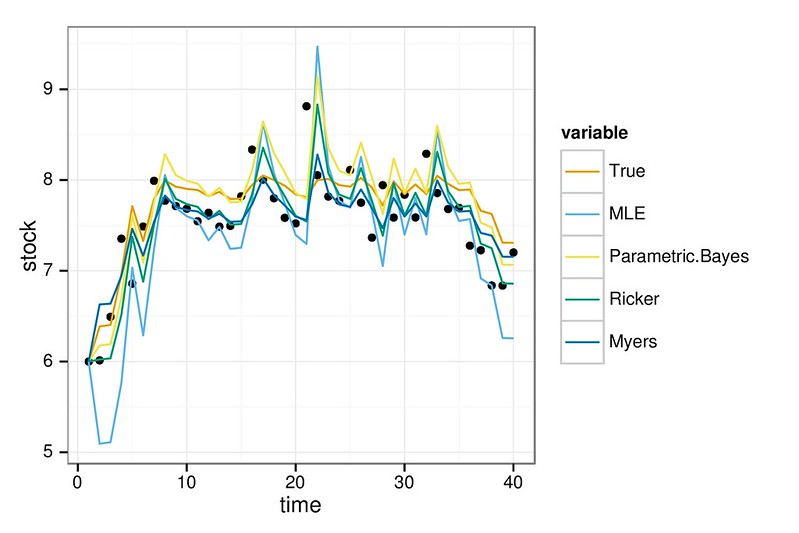Talk prep
- Finished preparing slides for Environmental Resources Economics talk
Toying around with animations for final plots. Building up plot by subsetting progressively more of the data each time is a bit of a nuciance (both in coding and efficiency). Can convert replicates to characters and assign as a data.table key for fast join subsetting, but straight-forward subsetting seems best (e.g. once we want reps 1:5 from both “True” and “Ricker” models, dt[J(c("True", "Ricker"), as.character(1:5)] doesn’t quite do this. (Can you guess what it gives? Actually alternates “True”+rep1, “Ricker”+rep2, “True”+rep3, …)
require(animation)
ani.options(loop=TRUE)
saveMovie({
for (i in seq(1, OptTime, by=2)) {
print(
ggplot(subset(dt, method %in% c("True", "Ricker") & reps < 5 & time <= i),
aes(time, fishstock, group=interaction(reps,method), color = method), alpha=.9) +
geom_line() + xlim(0, OptTime)
)
}
}, interval = 0.1, movie.name = "wrong-model.gif", ani.width = 600, ani.height = 600)Added plots of one-step-ahead predictors, e.g.

All plots for slides also archived in flickr/ere2013
Which were quickly converted from vector pdfs into decent resolution pngs with a few commands:
for f in *.pdf ; do convert -density 300 "$f" "${f/.pdf}".png ; done
flickr_upload --tag="nonparametric-bayes ere2013 talk" *.pngReading
- (Sirota et al. 2013 ) provide a cute example of a system that can be manipulated through a tipping point of eutrophication in the tiny pools forming inside pitcher plants by adding ground-up dead insects. A nice natural system that provides a more realistic setting than lab manipulations of single species micro-organisms while also being more accessible to replication that the whole-lake experiments in Wisconsin. I do note they critique retrospective analyses on the basis of length, but don’t mention the prosecutor’s fallacy. Five stars for archiving the raw data very nicely (see below) along with the mathematica notebook file used for the analysis. Also notable that the first author is an undergrad at North Dakota State.
- Wow, Harvard Forest provides a data repository with EML files for each data entry (example). EML file serves more as a metadata description, raw data provided as an 8.8 MB .csv file in tidy (long) format. Very nice.
- From the Whitehouse, executive order: The default state of new and modernized Government information resources shall be open and machine readable I can’t really express just how incredible that is. May it impact government funded science appropriately. Whitehouse Chief technology officer and chief information officer explain the policy in one minute
References
- J. Sirota, B. Baiser, N. J. Gotelli, A. M. Ellison, (2013) Organic-Matter Loading Determines Regime Shifts And Alternative States in an Aquatic Ecosystem. Proceedings of The National Academy of Sciences 110 7742-7747 10.1073/pnas.1221037110